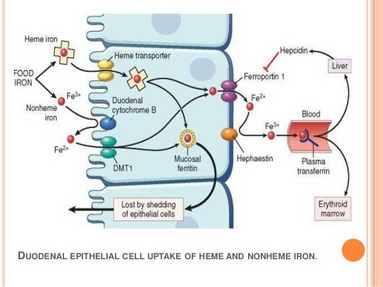How is iron absorbed in humans?
1 Answer
Here's what I find.
Explanation:
Of our total iron intake,
- About 10 % to 15 % comes from meat, fish, and poultry as heme
- About 85 % to 90% comes from grains and vegetables as non-heme iron
Absorption of heme iron
Most of the iron from digested food is absorbed through the duodenal villi.
Heme iron is moved across the cell membrane into the cytoplasm by facilitated transport through heme transporters.

(From SlideShare)
Proteolytic enzymes in the cytosol release the
Absorption of non-heme iron
To be absorbed, non-heme iron must be in the

(From ResearchGate)
A protein called divalent metal transporter 1 (DMT1) then transports the iron into the cell through the cell membrane.
The cell can then either
- store the
#"Fe"^"2+"# by complexing it as ferritin or - release the
#"Fe"^"2+"# into the body via the iron exporter, ferroportin
The enzyme hephaestin helps ferroportin transfer iron across the cell wall.
The

